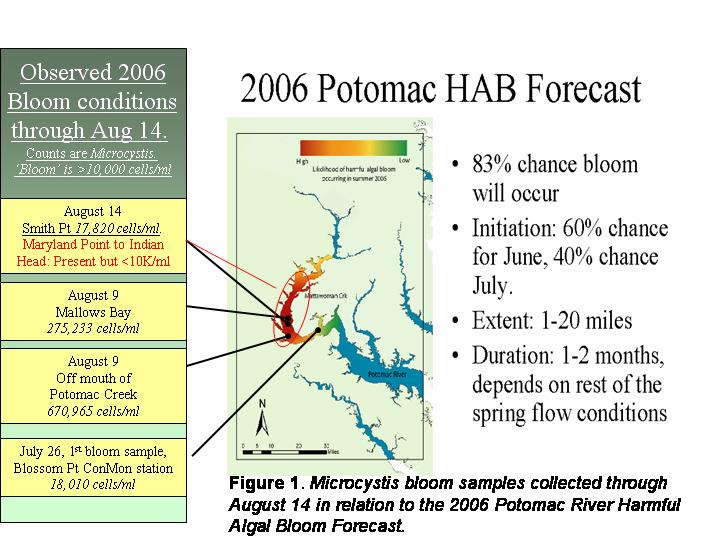|
||||||||||||||||||||||||||||||
The first 2006 summer bloom sample (>10,000 cells per milliliter Microcystis ) for cyanobacteria on the Potomac River was collected on July 26th by Maryland Department of Natural Resources (DNR) at the Blossom Point Continuous Monitoring Station and contained 18,191 cells per milliliter (Figure 1). A second team of DNR staff working on dataflow mapping of the river on August 9th collected samples from two areas, one near Maryland Point, the other at Mallow's Bay containing 670,965 and 275,233 cells per milliliter respectively (Figure 1). This was an area considered to have a high probability of bloom conditions in the 2006 Harmful Algal Bloom forecast for the Potomac River (Figure 1, also see Ecological Forecast of Chesapeake Bay Conditions at https://www.chesapeakebay.net/bayforecast.htm ).
On August 14th , DNR collected water from 9 long-term water quality monitoring stations along the Potomac River and tributaries of Mattawoman Creek and Piscataway Creek. Cyanobacteria cells were apparent in the water throughout approximately 20 miles of river from Maryland Point to Indianhead (Figure 2). Faint bands of higher cell concentrations were occasionally visible while traveling on the river, however, no surface scum regions were observed. Maximum concentrations for Microcystis were recorded at the Smith Point station (17,820 cells per milliliter) an area considered to have a high probability of bloom conditions in the 2006 Potomac River forecast (Figure 1). Other colonial cyanobacteria (i.e., Anabaena spp.) were present but were not dominant in the region. One sample was submitted for cyanobacterial toxin analysis; results are pending.
Table 1. Cyanobacteria cell counts on the Potomac River long term water quality monitoring stations, August 14th 2006 . Stations identified north to south (Figure 2).
Additional cyanobacteria bloom observations were recently reported by Eva Bailey of Chesapeake Biological Laboratory (August 9th) and Jeff Talbott of Virginia Department of Environmental Quality (August 23rd ). Both groups indicated sighting a local region of high density cyanobacteria bloom waters is persisting on Occoquan Bay and Neabsco Creek across the river the Mattawoman Creek. No counts are available from the Virginia location at this time (Figure 2).
Maryland Department of Natural Resources will continue to actively monitor and report on the condition of the river. Citizens are advised to take common precautions around bloom waters to reduce the possible risk of illness or discomfort related to blue-green algal blooms:
Please note that illness associated with harmful algal blooms is now a reportable illness so physicians should be reporting these to local health departments. The MD DNR in coordination and cooperation with DHMH and MDE will continue to monitor all blue-green algal blooms throughout the state. For up to date information on all of Maryland's harmful algal blooms and water quality, please visit Eyes on the Bay |


